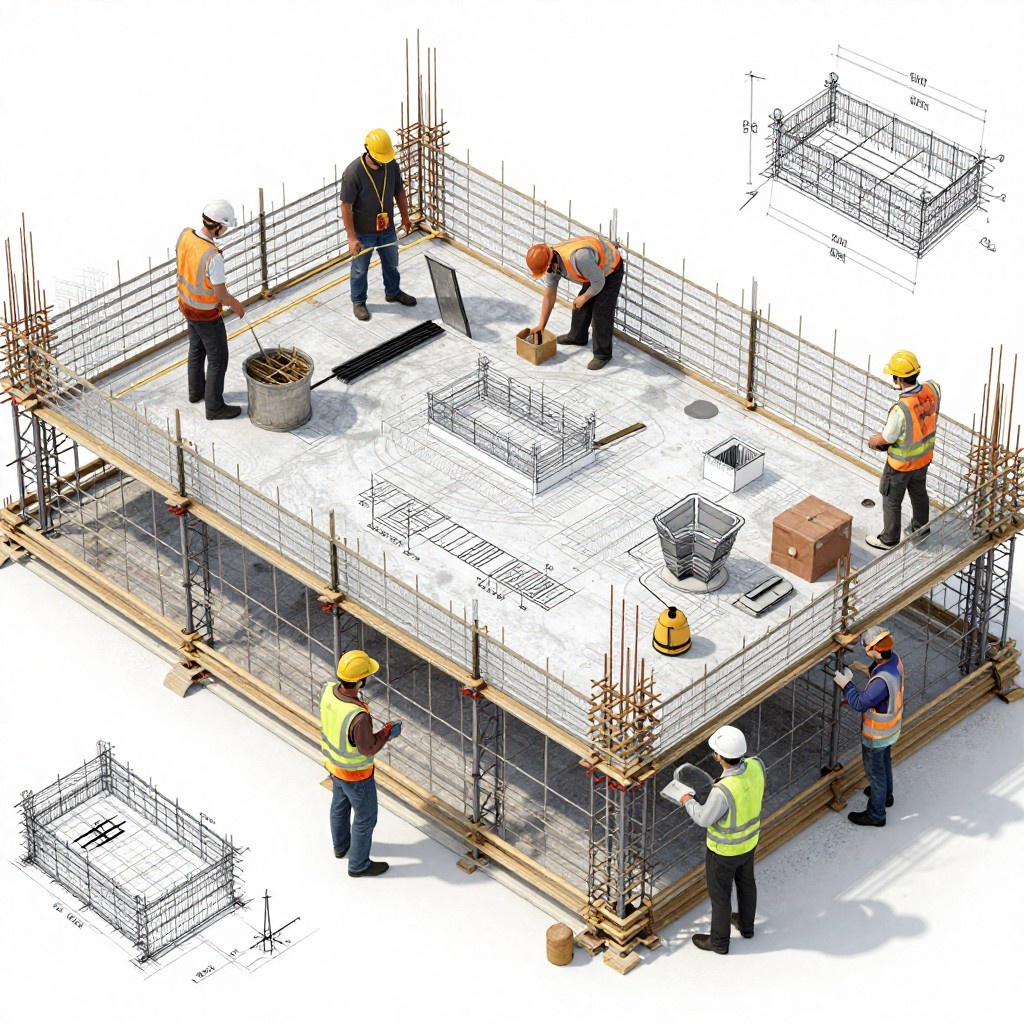The design, development, and administration of infrastructure and buildings have been revolutionized by the use of BIM. Building Information Modelling, or BIM, is a digital depiction of a facility's structural and operational features that acts as a common knowledge base for information throughout its existence.
BIM is a complex process of producing and maintaining digital representations of a location's functional and physical attributes. Throughout the course of a construction or infrastructure project, these digital representations—often called BIM models—are used.
What Is BIM?
BIM is defined as a digital depiction of a location's functional and physical attributes.
- Key Ideas: BIM is the process of creating and utilizing coordinated, consistent, and calculable data about a building project, from the planning and design stages till construction and maintenance phases. The three main features of BIM are as follows:
- 3D modelling: Creating three-dimensional digital models of infrastructure and buildings is essential to BIM.
- Data Integration: Relational, geometric, spatial, and geographic data are among the many forms of data that BIM integrates.
- Collaboration: Architects, engineers, contractors, and facilities managers are just a few of the stakeholders with whom BIM makes cooperation easier.
Importance of BIM in the Construction Industry
BIM has grown in significance in the construction sector, for a number of reasons. Better communication between the many stakeholders engaged in a building project, such as the architects, engineers, contractors, and clients, is made possible by BIM. BIM improves team collaboration, lowers mistakes, and facilitates communication by offering a centralised platform for exchanging and managing project data. BIM software helps in identifying any conflicts or clashes between different building elements, including structural parts, mechanical systems, and architectural aspects. Through the identification of these conflicts in the design stage, BIM assists in averting expensive rework and construction schedule delays.

How Does the BIM Process Function?
From design to construction and maintenance, the BIM process entails a number of processes. To improve its capabilities, it connects with a variety of technologies, including cloud computing, artificial intelligence, and virtual reality. An overview of BIM's sequential steps and how it interacts with other technologies is provided below:

- Project Planning and Initiation: Specify the needs, goals, and scope of the project. Determine the important parties involved and set up procedures for cooperation.
- Idea Generation: Make use of BIM tools to create preliminary design concepts.
Examine and assess the viability of other design possibilities.
- In-depth Planning and Creation: Using BIM, create intricate structural, architectural, and MEP (mechanical, electrical, and plumbing) designs. Work together with different disciplines to coordinate design components and settle disputes.
- 3D modelling for virtual construction: Using BIM software, create a detailed 3D model of the building and all of its parts. Include information such as materials, quantities, and spatial relationships.
- 3D and 2D Modelling: To construct 4D (scheduling) and 5D (cost estimate) models, integrate time and cost data with the 3D model.Determine possible effects on the budget and schedule by visualising the building sequences.
- Documentation for Construction: Utilising the BIM model, create construction drawings, requirements, and other paperwork. Make ensuring that every project document is accurate and consistent.
- Phase of Construction: For on-site building tasks including layout, coordination, and quality control, use the BIM model.Gather as-built data and update the BIM model to account for any changes made to the original plan.
- Maintenance and Management of Facilities: For facility management, use the BIM model as a central store for building information. Utilise BIM data to carry out maintenance planning, energy analysis, and restoration projects.
Integrating Other Technologies:
- Artificial intelligence (AI): By combining AI with BIM, repetitive processes can be automated, data can be analysed for insights, and decision-making can be strengthened. AI systems, for instance, can forecast maintenance requirements or optimise energy efficiency by analysing building performance data.
- Virtual Reality (VR): Stakeholders can experience and engage with the BIM model in immersive virtual worlds thanks to virtual reality (VR) technology. In addition to supporting virtual walkthroughs for construction planning and client presentations, this improves visualisation and streamlines design reviews.

- Cloud computing: Regardless of a project's stakeholders' geographical location, real-time collaboration and data sharing are made possible via cloud-based BIM platforms. In addition, cloud computing offers data protection, scalability, and accessibility, which improves team productivity across the project's many stages.
Throughout the course of a building project, BIM improves decision-making, analysis, visualisation, and collaboration by integrating with these technologies.
What Does BIM Do?
Understand the Site and Design Possibilities
Understanding site characteristics and examining design possibilities are made easier by BIM in a number of ways.
- Location Analysis: By combining topographical and geographic data, BIM can shed light on the prospects and limitations of the location. This contains data on wind direction, sun path analysis, geography, and environmental factors.

- Design Exploration: Using BIM software, designers and architects may rapidly generate and illustrate a variety of design choices. Through the use of parametric modelling and simulation tools, they are able to assess the viability and performance of various design options. This makes it easier to choose the best design solution depending on the needs of the project and the site conditions.
Manage Data
Effective data management across the project lifecycle is greatly aided by BIM by:
- Centralised Data Repository: BIM provides a centralised platform for storing, managing, and exchange of project-related data, such as structural, architectural, and MEP (mechanical, electrical, and plumbing) data. By ensuring that everyone involved in the project has access to the most recent data, this lowers the possibility of mistakes and inconsistencies.
- Version Control: BIM software keeps track of modifications made to the project model and enables users to go back to earlier iterations as needed. This keeps data integrity intact and makes it easier for project team members to work together.
- Interoperability: BIM systems facilitate data interchange between disciplines and project phases by supporting interoperability with a wide range of software programmes and file formats.

Get Comprehensive Building Design and Analysis Information
BIM offers thorough design data and analysis through:
- Parametric Modelling: Using BIM software, designers may produce intelligent three-dimensional (3D) models that incorporate embedded data on building materials, components, and attributes in addition to geometric data. Accurate quantity takeoffs, cost estimation, and scheduling may all be done with this information.

- Performance Analysis: BIM makes it possible to simulate and analyse a number of building performance factors, including daylighting, energy use, structural integrity, and thermal comfort. Building performance and sustainability can be maximised by architects and engineers by carrying out these assessments early in the design phase.

- Coordination and Clash Detection: Before construction starts, BIM helps identify conflicts and collisions between building systems, which makes it easier for different disciplines to coordinate. By doing this, delays and expensive rework are avoided throughout the building phase.
Manage Deliverables from a Centralized Location
BIM platforms offer tools for organizing and managing project documentation, including drawings, specifications, schedules, and reports. This guarantees that all stakeholders have access to the most recent project information while streamlining the document review and approval process.
Regardless of a project team member's location, BIM enables real-time cooperation amongst them. This makes project data accessible to several users concurrently and makes collaboration and communication easier throughout the project's lifecycle. By offering tools for comparing and validating design information against project requirements and standards, BIM helps guarantee the quality and accuracy of project deliverables. By doing this, mistakes and rework are reduced, improving project efficiency and results.
What Are the Benefits of BIM in Construction?
Better Coordination
Project stakeholders, such as architects, engineers, contractors, subcontractors, and owners, can collaborate in real time through BIM. Team members may work together effortlessly and access the most recent project data from any location using a centralised BIM platform. Better collaboration and communication are made possible throughout the project lifecycle as a result.

Clash Detection
Using BIM software, intricate 3D models of different building systems and elements, including structural, architectural, and MEP (mechanical, electrical, and plumbing) components, can be created. Because these models are so detailed and include so much geometry, BIM technologies can identify conflicts or clashes between various aspects in the design stage. Clash detection algorithms are used by BIM systems to automatically search the 3D model for conflicts according to preset standards and guidelines. These requirements might be clashes in system connection, clearance breaches, or spatial conflicts. By highlighting conflict points, the programme helps project participants recognise problems and take effective action. Construction delays and expensive rework are avoided by early clash identification and resolution. Teams may resolve disputes in the virtual environment, where changes are less expensive and time-consuming to perform than on-site adjustments, by recognising problems prior to construction commencing.

Better Management of Design Information
By arranging data logically and hierarchically, BIM improves how design information is arranged. Design components are arranged and labelled in the building model based on their kind, purpose, and placement. This organisation cuts down on the time and effort needed to find information by making it simpler for stakeholders to explore and retrieve essential design data.

Improved Scheduling
BIM makes it possible to create intricate 3D models that precisely depict the architecture and other elements of the structure. By giving project stakeholders a visual depiction of the project's scope, these models help them comprehend the order and interdependencies of the construction processes. Stakeholders can maximise construction sequences and spot any scheduling issues by using 3D visualisation of the project.

Clarity Amongst Stakeholders and Involved Parties
Before construction starts, BIM enables stakeholders to visualize the project in a virtual setting. This facilitates a clearer comprehension of the design objective and the early detection of any potential conflicts or disputes. Stakeholders can investigate various possibilities and assess their effects on the project by using simulation tools. BIM also ensures that all stakeholders have access to the same information hence reducing the chances of any misunderstanding or discrepancies. BIM facilitates communication among stakeholders through collaborative features such as model sharing and cloud-based platforms. This enables teams, irrespective of their location, to communicate, resolve problems, and make well-informed decisions in real-time.
Increased Ability to Renovate and Retrofit Projects
By digitally documenting the building's present conditions, BIM enables the compilation of accurate as-built documentation. This contains comprehensive details regarding the MEP systems, finishes, building structure, and other elements. To properly plan rehabilitation or retrofitting projects and comprehend the current building characteristics, accurate as-built documentation is necessary. Stakeholders may evaluate the energy efficiency and performance of existing buildings with the use of BIM technologies, which offer energy analysis and performance simulation capabilities. Stakeholders may find ways to optimise energy use, enhance interior comfort, and save operating costs by modelling various remodelling scenarios.

Reduced Cost and Mitigated Risk
During the design stage, BIM enables the detection of clashes between various building elements, assisting in the identification and resolution of conflicts prior to the start of construction. Early resolution of conflicts reduces the need for expensive rework and delays during construction, saving money and time. By taking information straight out of the model, BIM makes precise quantity takeoffs and automatic cost estimation possible. By doing away with the necessity for human measuring and calculation, this lowers the possibility of mistakes and inconsistencies in project costs. By offering a thorough platform for data analysis and visualisation, BIM makes risk detection and management easier. Project risks pertaining to design, construction, scheduling, and budgeting may be evaluated by stakeholders, enabling the proactive use of risk mitigation techniques.
Safer Construction Sites
BIM plays a crucial role in enhancing construction site safety by providing tools and technologies that enable proactive hazard identification, risk assessment, and safety planning. Identifying possible dangers and creating efficient preventative measures are made much easier by BIM's ability to visualise, simulate, and coordinate various aspects of a project. BIM models can be equipped with Safety-specific data, such as details regarding construction materials, equipment, and access points. Project teams can identify potential safety issues associated with working at heights, restricted spaces, fire dangers, and other situations by modelling the building process in a virtual environment.
The clash detection capability in BIM is essential for safety analysis. It detects conflicts between various building elements, such as HVAC ducting blocking escape routes or electrical conduits interfering with structural elements. By resolving these conflicts virtually, a safer working environment is ensured and safety concerns on the real building site are avoided.

Increased ROI
The management and execution of construction have been transformed by BIM. Key findings from a thorough survey by Becerik-Gerber and Rice were as follows: Of those surveyed, 41% saw a rise in project profitability, and 55% said that BIM assisted in cost reduction.
What's even more astounding is that half of the latter reported a 50% project cost decrease. Moreover, a 50% decrease in the project's overall time was noted by 58% of respondents. These figures demonstrate how importantBIM is for increasing the return on investment of construction projects.
Related expenses may be changed right away with real-time visualisation of project modifications. For instance, altering a building's materiality—for instance, switching from a brick to a glass façade—instantly changes implementation and material costs.
Conclusion
The potential for BIM are endless in the future. A plethora of new tools and technologies are available to manufacturers. To capitalise on these prospects, however, producers will need to make the required investments in tools and training, as well as keep abreast of industry advancements.
Construction companies are using more and more BIM objects, thus it is critical for manufacturers to make sure their products are compatible with BIM in order to be ready for these developments. Manufacturers may seize new chances for development, efficiency, and innovation by adopting these technologies. It's time to begin investigating what BIM has to offer. There are countless opportunities and an exciting future ahead of us.
Overall, BIM's increasing significance in the construction industry is due to its capacity to provide observable advantages in the areas of productivity, resilience, sustainability, regulatory compliance, risk management, teamwork, technological innovation, and meeting global trends and challenges. BIM's revolutionary effect on the construction industry will only increase as it develops and becomes more integrated into workflows and practices.




